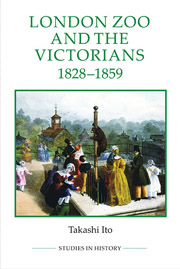Book contents
- Frontmatter
- Contents
- List of figures
- List of tables
- Acknowledgements
- Abbreviations
- Dedication
- Introduction: the zoo in history
- 1 The site of animal spectacle
- 2 Collecting and displaying
- 3 The question of access
- 4 Between science and commerce
- 5 Illusionary empire
- Conclusion: the Darwinian moment
- Appendix
- Bibliography
- Index
5 - Illusionary empire
Published online by Cambridge University Press: 05 April 2014
- Frontmatter
- Contents
- List of figures
- List of tables
- Acknowledgements
- Abbreviations
- Dedication
- Introduction: the zoo in history
- 1 The site of animal spectacle
- 2 Collecting and displaying
- 3 The question of access
- 4 Between science and commerce
- 5 Illusionary empire
- Conclusion: the Darwinian moment
- Appendix
- Bibliography
- Index
Summary
The zoo and science interacted with each other in various ways. The zoo was a platform for rising zoologists who sought to authenticate their scientific activities, but it also problematised relationships between science and its public by raising the question of accessibility. It has also been argued that the London Zoo embodied the boundary between the separate scientific spheres: as a site of ‘recreational science’, it formed a bridge between the scientific community and the non-specialist public, and provided financial and material resources for ‘legitimate science’. Yet this book has not explored exactly what kind of science was being engaged in at the London Zoo. This chapter thus contemplates the question of science by tracing David Mitchell's attempt to reconfigure the zoo as an institute of ‘acclimatisation’ – a new form of science that he believed would employ the knowledge and materials available at the zoo.
The validity of the concept of ‘imperial zoo’ can also be tested through a study of acclimatisation. It can be seen as a particular form of the science/empire symbiosis that demonstrated the dynamic interactions between home institutions and the colonial field. The trajectory of acclimatisation at the London Zoo, however, does not necessarily underline this interpretation. Certainly, it appears to be a manifestation of the British imperial intervention in colonial nature. It was indeed an ambitious attempt to regenerate the zoo as a centre of ‘zoological empire’, which would use animals as colonial resources on an unprecedentedly large scale.
- Type
- Chapter
- Information
- London Zoo and the Victorians, 1828-1859 , pp. 138 - 161Publisher: Boydell & BrewerPrint publication year: 2014

